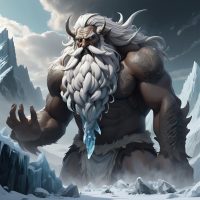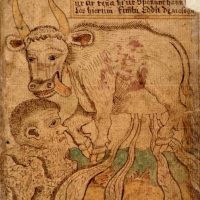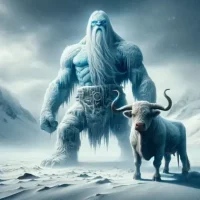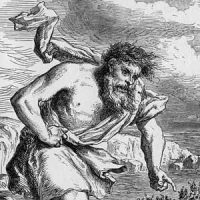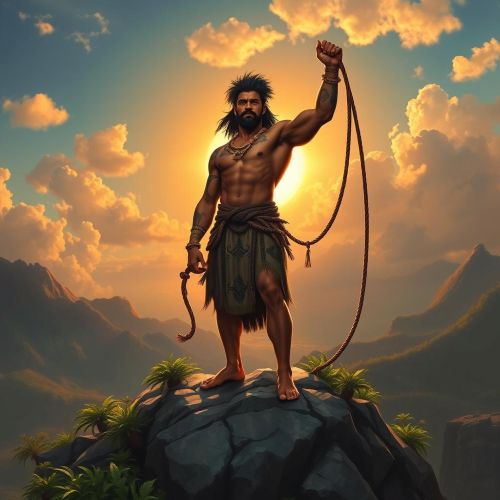Ymir : The First Giant
Listen
At a glance
| Description | |
|---|---|
| Origin | Norse Mythology |
| Classification | Mortals |
| Family Members | N/A |
| Region | Iceland, Norway, Denmark |
| Associated With | Creation |
Ymir
Introduction
Ymir, a name synonymous with the dawn of existence, is a pivotal figure in Norse mythology. As one of the oldest beings, he embodies the essence of creation and the eternal struggle between order and chaos. Standing as a colossal giant, Ymir’s role in the world’s creation is profound. Norse mythology depicts the pre-creation universe as Ginnungagap, a void where Niflheim’s icy mist met Muspelheim’s fiery heat. It was within this clash of elements that Ymir emerged. According to the Poetic Edda, he formed from the venomous ice of Niflheim, springing into life as the first primeval giant, ancestor to all jötnar (giants) in Norse lore.
Physical Traits
Ymir, a colossal being, epitomized the raw power of the primordial world. Myth recounts his emergence from Ginnungagap, the icy void preceding the cosmos. Towering over the landscape, his form was frost and rime incarnate, embodying the primal forces of ice and cold. Descriptions of Ymir’s physique are scarce, yet his immense power is undeniable. Often depicted as a giant, he dwarfs mountains with unmatched strength. Some portray him as a man of titanic proportions, while others suggest a more monstrous visage, highlighting his link to nature’s chaotic forces. Ymir, progenitor of the frost giants, didn’t birth in the conventional sense but emerged from the fusion of fire and ice. From his body sprang the first male and female giants, establishing him as the giant race’s ancestor in Norse lore.
Family
Ymir’s lineage remains mysterious, mirroring the cosmos’ enigmatic beginnings. Though his parentage is uncertain, he’s often seen as the progenitor of frost giants, denizens of icy Jotunheim. Some tales even attribute to him the parentage of the formidable jötnar, whose clashes with gods shaped the world’s destiny. Ymir, solitary at birth, became the fount of life. As per the Prose Edda, while he slept, sweat beneath his arm bore a giant pair, and his legs spawned the six-headed Thrudgelmir. These giants, along with Ymir, birthed the frost giants, potent adversaries in Norse lore. Despite his role as giant forebear, Ymir isn’t deified but depicted as an elemental force, embodying primordial chaos before divine realms emerged. Yet, unwittingly, his slumber contributed to world creation and the ascent of Norse gods.
Other names
Throughout Norse mythology, Ymir is known by multiple names, each reflecting different facets of his nature and cosmic role. Alongside Ymir, he’s referred to as Aurgelmir or Brimir, evoking his status as the giants’ primal ancestor. These titles underscore his link to elemental ice and frost, emphasizing his foundational role in Norse cosmology. Ymir isn’t confined to a single name; he appears under various aliases, each offering a unique perspective on his complexity. Aurgelmir, translating to “primeval slime” or “mud-well,” highlights his emergence from primordial elements. Brimir, meaning “the rafter-shaker,” emphasizes Ymir’s immense size and strength, suggesting his movements could shake existence’s foundations. Bláinn, translating to “the blue one,” potentially alludes to Niflheim’s icy origin and his association with cold. Ymir’s other names, like Aurgelmir among giants, reflect different aspects of his character and mythic role.
Powers and Abilities
As the primordial giant from whom the world was born, Ymir wielded immense power and influence, shaping reality itself. His body formed the substance of the earth, while his blood flowed as rivers and seas. Even in death, Ymir’s essence endured, perpetuating the cycle of creation and destruction in the Norse cosmos. As the first being and ancestor of giants, Ymir possessed extraordinary abilities, drawing strength from the primal forces of ice and fire. His colossal size translated into formidable strength, making him a powerful adversary. His connection to primal elements likely granted him incredible resilience, enabling him to endure harsh conditions and powerful attacks. Ymir’s ability to birth beings through sleep and sweat suggests latent creative power within him. As a primordial being, he thrived in the harsh environs of Niflheim and endured the intense heat of Muspelheim. Yet, his most significant contribution lay not in his power, but in his demise, as his body formed the world, underscoring his pivotal role in the cosmogonic myth.
Modern Day Influence
Norse mythology’s ancient roots still reverberate in contemporary culture, with Ymir’s legacy continuing to captivate modern audiences across literature, film, art, and video games. Renewed interest in Norse mythology ensures Ymir’s enduring presence, resonating for generations to come. In modern literature and pop culture, Ymir inspires characters and storylines, infusing modern fantasy and fiction with his mythic power. Role-playing games often feature him as a formidable adversary or enigmatic figure, evoking the awe and terror of this mythical giant. Even in scientific discourse, Ymir’s cyclical existence, born from elemental clashes, offers inspiration.
Specifically, in popular culture, the anime series Attack on Titan draws heavily from Norse mythology, featuring a colossal being named “Ymir” as the first Titan, with the city walls named after his body parts. The online video game Smite depicts Ymir as a frost giant wielding ice and snow as weapons, faithfully reflecting his Norse portrayal. In God of War (2018), while not directly named, the character Mimir shares traits with Ymir, possessing vast knowledge of creation and a connection to primal forces.
Ymir’s influence extends to metal music, with bands like Amon Amarth and Borknagar referencing him as a powerful force, embodying raw and untamed nature. Ymir’s presence in modern culture underscores his enduring significance, serving as a symbol of strength and size, despite his antagonistic role in mythology.
Related Images
Frequently Asked Questions
What is lorem Ipsum?
I am text block. Click edit button to change this text. Lorem ipsum dolor sit amet, consectetur adipiscing elit. Ut elit tellus, luctus nec ullamcorper mattis, pulvinar dapibus leo.
What is lorem Ipsum?
I am text block. Click edit button to change this text. Lorem ipsum dolor sit amet, consectetur adipiscing elit. Ut elit tellus, luctus nec ullamcorper mattis, pulvinar dapibus leo.
What is lorem Ipsum?
I am text block. Click edit button to change this text. Lorem ipsum dolor sit amet, consectetur adipiscing elit. Ut elit tellus, luctus nec ullamcorper mattis, pulvinar dapibus leo.
What is lorem Ipsum?
I am text block. Click edit button to change this text. Lorem ipsum dolor sit amet, consectetur adipiscing elit. Ut elit tellus, luctus nec ullamcorper mattis, pulvinar dapibus leo.
What is lorem Ipsum?
I am text block. Click edit button to change this text. Lorem ipsum dolor sit amet, consectetur adipiscing elit. Ut elit tellus, luctus nec ullamcorper mattis, pulvinar dapibus leo.

